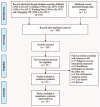Meta-analysis of computed tomography angiography versus magnetic resonance angiography for intracranial aneurysm
- PMID: 29768368
- PMCID: PMC5976319
- DOI: 10.1097/MD.0000000000010771
Meta-analysis of computed tomography angiography versus magnetic resonance angiography for intracranial aneurysm
Abstract
Background: Whether the diagnosis value of computed tomography angiography (CTA) for intracranial aneurysm is in accordance with magnetic resonance angiography (MRA) remains inconclusive. This meta-analysis aims to synthesize relevant studies to compare the diagnostic efficacies of the 2 methods.
Methods: Potentially relevant studies were selected through PubMed, Embase, Wanfang, Chongqing VIP, and China National Knowledge Infrastructure databases by using the core terms "computer tomography angiography" (CTA) and "magnetic resonance angiography" (MRA) and "intracranial aneurysm*" in the titles, abstracts, and keywords of the articles. Quality Assessment for Diagnostic Accuracy Studies (QUADAS-2) was utilized to evaluate the quality. Pooled sensitivity, specificity, positive likelihood ratio (PLR), negative likelihood ratio (NLR), and diagnostic odds ratio (DOR) were count. Summary receiver operating characteristic curves (SROC) and area under the curve (AUC) were used to summarize the overall diagnostic performance. Statistical analyses were performed by Stata version 12.0 and MetaDisc 1.4 software.
Results: Ten articles were identified in this current paper. For CTA, the pooled estimates of diagnostic parameters for intracranial aneurysm were as follows: sensitivity, 0.84 (95%CI = 0.81-0.86); specificity, 0.85 (95%CI = 0.79-0.89); PLR, 4.09 (95%CI = 2.45-6.81); NLR, 0.18 (95%CI = 0.11-0.28); DOR, 23.74 (95%CI = 10.49-53.74); AUC, 0.90, respectively. For MRA, the pooled estimates of diagnostic parameters for intracranial aneurysm were as follows: sensitivity, 0.80 (95%CI = 0.77-0.83); specificity, 0.87 (95%CI = 0.82-0.91); PLR, 3.61 (95%CI = 1.72-7.55); NLR; 0.27 (95%CI = 0.21-0.35); DOR, 16.77 (95%CI = 7.38-38.11); AUC, 0.87, respectively. No significant difference was found the AUC value between CTA and MRA for intracranial aneurysm (Z = 0.828, P > .05).
Conclusion: This comprehensive meta-analysis demonstrated that the diagnosis value of CTA was in accordance with MRA for intracranial aneurysm. However, considering the limitation of sample size, the results should be treated with caution.
Conflict of interest statement
The authors have no conflicts of interest to disclose.
Figures






Similar articles
-
Diagnostic value of 3D time-of-flight magnetic resonance angiography for detecting intracranial aneurysm: a meta-analysis.Neuroradiology. 2017 Nov;59(11):1083-1092. doi: 10.1007/s00234-017-1905-0. Epub 2017 Sep 8. Neuroradiology. 2017. PMID: 28887618 Review.
-
Diagnostic accuracy of computer tomography angiography and magnetic resonance angiography in the stenosis detection of autologuous hemodialysis access: a meta-analysis.PLoS One. 2013 Oct 23;8(10):e78409. doi: 10.1371/journal.pone.0078409. eCollection 2013. PLoS One. 2013. PMID: 24194928 Free PMC article.
-
Gadolinium-enhanced magnetic resonance versus computed tomography angiography for renal artery stenosis: A systematic review and meta-analysis.J Formos Med Assoc. 2021 May;120(5):1171-1178. doi: 10.1016/j.jfma.2021.01.007. Epub 2021 Feb 12. J Formos Med Assoc. 2021. PMID: 33583703
-
Role of non-contrast balanced steady-state free precession megnetic resonance angiography compared to contrast-enhanced megnetic resonance angiography in diagnosing renal artery stenosis: a meta-analysis.Chin Med J (Engl). 2014;127(19):3483-90. Chin Med J (Engl). 2014. PMID: 25269918
-
Meta-analysis of the value of dual-energy computed tomography in the diagnosis of anterior cruciate ligament injuries of the knee.BMC Musculoskelet Disord. 2024 Jul 18;25(1):557. doi: 10.1186/s12891-024-07632-6. BMC Musculoskelet Disord. 2024. PMID: 39020351 Free PMC article.
Cited by
-
Long non-coding RNA NORAD induces phenotypic regulation of vascular smooth muscle cells through regulating microRNA-136-5p-targeted KDM1A.Cell Cycle. 2021 Oct;20(20):2137-2148. doi: 10.1080/15384101.2021.1971351. Epub 2021 Sep 29. Cell Cycle. 2021. PMID: 34583619 Free PMC article.
-
Deep Learning for Detection of Intracranial Aneurysms from Computed Tomography Angiography Images.J Digit Imaging. 2023 Feb;36(1):114-123. doi: 10.1007/s10278-022-00698-5. Epub 2022 Sep 9. J Digit Imaging. 2023. PMID: 36085330 Free PMC article.
-
Neurovascular Imaging with Ultra-High-Resolution Photon-Counting CT: Preliminary Findings on Image-Quality Evaluation.AJNR Am J Neuroradiol. 2024 Oct 3;45(10):1450-1457. doi: 10.3174/ajnr.A8350. AJNR Am J Neuroradiol. 2024. PMID: 38760079
-
Assessing workflow impact and clinical utility of AI-assisted brain aneurysm detection: A multi-reader study.Neuroimage Clin. 2025 Jun 28;47:103835. doi: 10.1016/j.nicl.2025.103835. Online ahead of print. Neuroimage Clin. 2025. PMID: 40614427 Free PMC article.
-
Dimensions and forms of artefacts in 1.5 T and 3 T MRI caused by cochlear implants.Sci Rep. 2022 Mar 22;12(1):4884. doi: 10.1038/s41598-022-08988-2. Sci Rep. 2022. PMID: 35318407 Free PMC article.
References
-
- Thien A, See AA, Ang SY, et al. Prevalence of asymptomatic unruptured intracranial aneurysms in a Southeast Asian population. World Neurosurg 2017;97:326–32. - PubMed
-
- Juvela S. Prevalence of and risk factors for intracranial aneurysms. Lancet Neurol 2011;10:595–7. - PubMed
-
- Vlak MH, Algra A, Brandenburg R, et al. Prevalence of unruptured intracranial aneurysms, with emphasis on sex, age, comorbidity, country, and time period: a systematic review and meta-analysis. Lancet Neurol 2011;10:626–36. - PubMed
-
- Juvela S, Korja M. Intracranial aneurysm parameters for predicting a future subarachnoid hemorrhage: a long-term follow-up study. Neurosurgery 2017;81:432–40. - PubMed
Publication types
MeSH terms
LinkOut - more resources
Full Text Sources
Other Literature Sources
Medical

